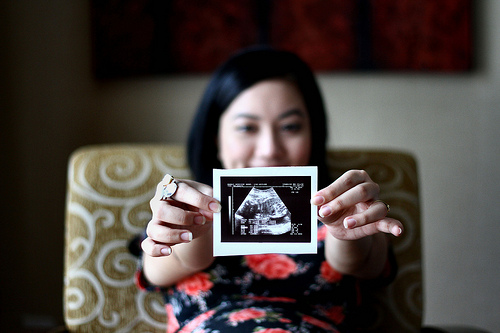Week 1
After the egg is successfully fertilized, the ovum starts forming. Before you go to the doctor’s, you’ll need to note the date of your last period.
Week 2
Conception starts here; you may experience mood swings.
Week 3
The embryo attaches to the uterus. Congratulations, you’re pregnant!
Week 4
The placenta, embryo, and amniotic sac continue developing.
Week 5
The embryo is growing fast; the heart and circulatory system are developing. Your hCG hormone levels are high enough to confirm that you’re pregnant through a home test.
Week 6
The fetal heartbeat can be detected through an ultrasound. You feel tired and may want to sleep a lot during the daytime.
Week 7
The left atrium and right ventricles have formed in the heart, which beats regularly at 150 beats per second. The early signs of pregnancy can be felt such as nausea, vomiting, and weakness.
Week 8
The embryo is growing at a rate of about 1mm per day and the organs have formed. It’s recommended to get your first ultrasound.
Week 9
The embryo grows into a fetus. The uterus becomes as big as a fist and starts to press against the bladder, causing frequent urination.
Week 10
The fetus measures up to 40mm and weighs up to 10g. You may experience mood swings due to hormones.
Week 11
The fetus starts sucking, swallowing, and kicking inside the womb. Organs such as the liver, kidneys, intestine, brain, and lungs start functioning. You can hear the fetal heartbeat with some assistance. Because the fetus’ bones will develop quickly from here on, you should consume more calcium.
Week 12
The fetus is about 6cm long. Its fingers and toes have completely separated. From this week on, you should get regular prenatal examinations, including blood tests and ultrasounds.
Week 13
Congratulations, you’ve made it through your first trimester – the most precarious months of pregnancy. From now on, the fetus will grow at an accelerated rate and you’ll need to increase the amount of nutrients you consume.
Week 14
The fetus is 8-9cm long. The hair and eyebrows have grown out. Your uterus will expand more and more, causing the belly to bulge. Your pregnancy is starting to show.
Week 15
The fetus measures 10-12cm long and weighs 50g. The ears develop, allowing the fetus to hear Mom for the first time. There will an obvious bulge 7.6-10cm below your belly button.
Week 16
The fetus’ limbs have formed completely and it will start sucking its own fingers. The screening for Down’s syndrome can be done.

Week 17
The fetus is growing fast, gaining weight rapidly, and starting to twist and kick within the womb. You may experience nasal congestion, nosebleeds, and prominent veins on your limbs. Don’t worry; these are caused by hormonal changes.
Week 18
The fetus is practicing its breathing by squeezing amniotic fluid out of its lungs. Your uterus will continue to grow, causing your center of gravity
to constantly change. You’ll need to adjust yourself frequently to find a comfortable standing and sleeping position.
Week 19
The fetus’ hearing continues to develop. You and your partner should talk to it often to help it recognize your voices.
Week 20
The fetus’ limbs have developed completely. The hair is also growing fast and the kidneys start producing urine. Congratulations! You are halfway through pregnancy.
Week 21
A film of fat called vernix will start covering the fetus, providing protection for its skin. As the growing uterus starts pressing against your lungs, you may find yourself a bit short of breath.
Week 22
The fetus’ eyebrows and eyelids can be clearly seen. Nails have formed on its tiny fingers. Pregnancy discomfort starts to recede; this phase is considered the most pleasant.
Week 23
The fetus’ five sense organs are detectable and its retinas have formed, granting it limited vision. You may experience increased vaginal discharge, which is normal during the second trimester. If the discharge is sticky or yellow, consult your doctor.
Week 24
Fetal movement becomes frequent, active, and regular. Prenatal care for this week should include a blood glucose test.
Week 25
The taste buds on the fetus’ tongue start to form. You may experience dry eyes and sensitivity to light; this is normal.
Week 26
The fetus’ hearing has developed completely and it may be more sensitive to sound. Your belly is growing bigger and bigger. You may experience slight pain in your waist and abdomen as well as numbness in your legs. Your partner can help by massaging them to relieve swelling and discomfort.
Week 27
Fetal sleep patterns are becoming increasingly regular. During late pregnancy, your uterus is closer to the edge of your ribs. As the fetus grows, you may experience more back and leg pain.
Week 28
The fetus is able to turn around in the uterus. From this week on, you should get prenatal examinations every other week. It’s also recommended to attend a prenatal class to prepare for delivery and breastfeeding.
Week 29
Your fetus’ vision has fully developed. If any light comes through the uterine wall, the fetus will open its eyes and turn its head towards the light. You may experience occasional false contractions; this is normal.
Week 30
The fetus responds more and more to sound. Your belly is so big that you can’t see your feet, and it becomes more and more difficult to move. You need regular prenatal exams.
Week 31
The fetus’ lungs and digestive system are almost fully-formed. The base of your uterus has risen to the diaphragm, leading to shortness of breath.
Week 32
The fetus starts to practice urinating. This week, your prenatal care should include routine examinations and an ultrasound.
Week 33
The fetus measures around 48cm and weights about 2kg. The development of its reproductive organs is almost complete. You may need to urinate more frequently, as the head of the fetus is descending and pressing against the bladder.
Week 34
The head of the fetus has descended to the pelvis; it’s getting ready for birth. It’s time for a routine prenatal examination.
Week 35
The fetus’ lungs and central nervous system are fully developed. It continues to grow and descend. You may feel heavy in the belly, slight pain in your waist, numbness in the muscles behind the pelvis, and difficulty moving.
Week 36
The fetus’ circulatory, respiratory, digestive, and reproductive organs are fully developed. Time for another routine prenatal examination.
Week 37
By the end of this week, the fetus can be considered a full-term baby. Prenatal care for this week includes routine examinations and an ultrasound.
Week 38
The fetus is fully-developed and can survive outside of the womb. During this week, you should pay close attention to your body’s changes and prepare for delivery. There will be another routine examination.
Week 39
The fetus’ weight is increasing and the vernix will help regulate its body temperature. You may experience irregular contractions, a sign that your body is ready for delivery. And you guessed it – yet another routine examination.
Week 40
Before the birth, you’ll get one last examination. When the baby is ready to come out, you’ll experience stronger and stronger contractions. When they happen every five minutes and last one minute each, get to the hospital for delivery. Congratulations! You have a brand-new baby.
Say What?
Here are some of the prenatal tests you’ll encounter and what they screen for.
PT/PTT: Both of these tests determine how quickly your blood clots, which is important for the doctor to know before any potential surgery.
Blood group (ABO+RH): This test determines your blood type (O, A, B, or AB) and Rh antigen (Rh-positive or Rh-negative). If an Rh-negative mother carries a Rh-positive baby, it can result in a serious condition called hemolytic disease in which the red blood cells break down. This can be prevented by giving Rh-negative mothers RhoGAM after delivery.
Screening for Down’s syndrome: The first screening is usually done in the first trimester, between 11 and 13 weeks of pregnancy. The results are given as a percentage of likelihood that you’ll have a baby with Down’s syndrome. If the likelihood is high, the doctor will order a diagnostic test to confirm the results.
Fetal heart doppler: This monitors fetal heartbeat, which varies in rate depending on the phase of the pregnancy.
Group B streptococcus screening: Group B Streptococcus (GBS) is a normal bacterium found in the intestinal tract; around 30 percent of women have it. However, it can cause complications like sepsis, pneumonia, or meningitis when transmitted from mother to baby. This screening determines whether the mother is a GBS carrier.
Special thanks to New Century Women and Children’s Hospital for providing the timeline.
This article originally appeared on page 12-14 of the beijingkids Health Guide 2014. To get your free copy, email distribution@truerun.com or view it online at Issuu.




